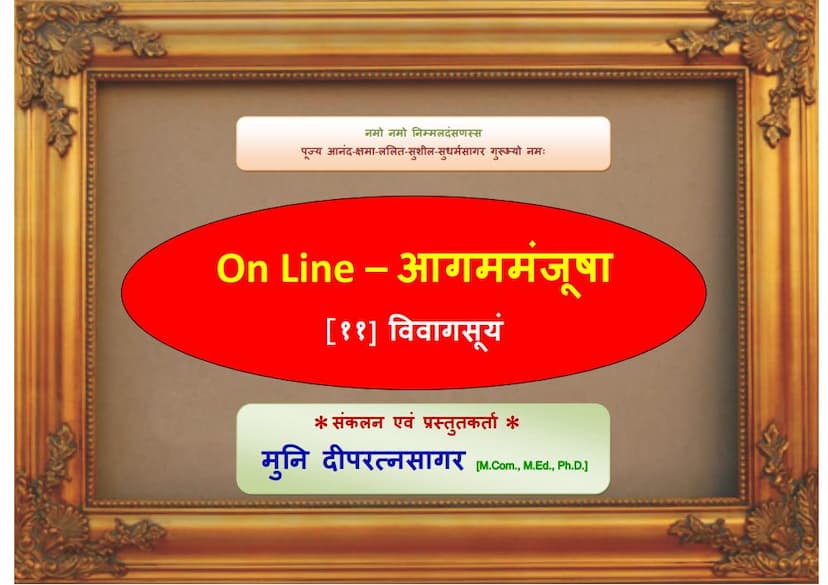Aagam Manjusha 11 Angsuttam Mool 11 Vivagsuyaam
Added to library: September 1, 2025

Summary
This Jain text, Aagam Manjusha 11 Angasuttam Mool 11 Vivagsuyaam, edited and presented by Muni Deepratnasagar, is a digital online version of the original Aagam Manjusha which was compiled approximately 70 years prior. The original was edited by Acharya Anand Sagar Suriji, and this online version aims to provide the same content with some minor useful changes.
The introduction highlights that the original Aagam Manjusha was a significant compilation, and this online version is a continuation of that legacy. It also notes some variations from the original compilation, such as the inclusion of Niyukti (commentary) along with the basic sutras in Avasyak Sutra and Jitakalpa Sutra, and the inclusion of the alternative Panchakalpa commentary. The Pindaniryukti is also included, but with a changed print location. The Kalpa (Barsa) Sutra is also mentioned as being part of the original compilation.
The core of the provided text is the Vivaksha Sutra (विवागसूयं), which is the eleventh Anga of the Jain Agamas. It begins with an invocation and then launches into a narrative in the Ardhamagadhi Prakrit language, common in Jain scriptures.
The text details the teachings of Bhagwan Mahavir through dialogues between his disciples, primarily between Arya Suhamma and Arya Jambu. The central theme of the Vivaksha Sutra is the consequences of actions (Karma Vipaka), categorized into Duhkhavivaka (consequences of suffering) and Sukhavivaka (consequences of happiness).
The text then delves into a detailed narrative illustrating these principles through various stories of past lives and their present-day manifestations. These stories often involve:
- The concept of rebirth: Individuals are shown to experience the results of their past actions in their current lives.
- The impact of actions: The narratives emphasize how good deeds lead to pleasant experiences and bad deeds lead to suffering, often across multiple lifetimes.
- Specific examples: The text presents detailed accounts of individuals who were born with severe disabilities due to past negative karma, and others who experienced great fortune due to past positive karma.
- The cycle of suffering: The narratives often trace a long journey through various animal realms and hellish existences before a human rebirth, highlighting the extensive consequences of karma.
- The role of compassion and renunciation: The stories implicitly encourage the adoption of the Jain path of right faith, right knowledge, and right conduct as a means to break free from the cycle of suffering.
Key stories and characters within the Vivaksha Sutra, as presented in this excerpt, include:
- Mrigaputra (मृगापुत्र): A story about a prince born with severe disabilities, tracing his past lives and the karma that led to his condition. This section emphasizes the immense suffering caused by negative karma.
- Ujjiyaka (उज्झियक): A narrative about a person who experiences extreme suffering and torment in his current life due to his past misdeeds. This story highlights the brutal consequences of actions like theft and violence.
- Abhaggasena (अभग्गसेण): The story of a prince who becomes a notorious bandit leader, illustrating how greed and violence lead to a cycle of suffering and eventual painful demise.
- Shakata (सगडे): A narrative about a person who becomes a charioteer and then a bandit, depicting the karmic consequences of his actions, including imprisonment and suffering.
- Bahushrutadatta (बहस्सतिदत्ते): The story of a scholar-priest who commits harmful acts and consequently faces severe suffering in his subsequent lives, emphasizing the dire consequences of misusing knowledge and causing harm.
- Nandisena (णंदिसेणे): A prince who harbors ill intentions towards his father and is punished for his actions, highlighting the negative repercussions of ambition and malice.
- Umbaradatta (उंबरदत्ते): The narrative of a person who performs harmful acts related to animal sacrifice and faces immense suffering in hell and subsequent births.
- Shoridatta (सोरियदत्ते): The story of a fisherman who engages in cruel practices and suffers greatly due to his karma.
- Devadatta (देवदत्ता): The tale of a princess who is mistreated and ultimately suffers due to her past actions and the machinations of others.
- Anjusri (अंजू): The narrative of a princess who experiences illness and suffering due to her past karma.
The text concludes with the classification of the Vivaksha Sutra into two parts: Duhkhavivaka (suffering-related consequences) and Sukhavivaka (happiness-related consequences). The Duhkhavivaka section is stated to contain ten chapters, while the Sukhavivaka section also has its own set of chapters, indicating the comprehensive nature of the teachings on karma.
In essence, Aagam Manjusha 11 Angasuttam Mool 11 Vivagsuyaam serves as a digital gateway to the profound Jain teachings on karma, illustrating through extensive narratives the intricate web of cause and effect that governs existence across lifetimes. It emphasizes the importance of righteous conduct and the eventual liberation from suffering through adherence to the Jain path.